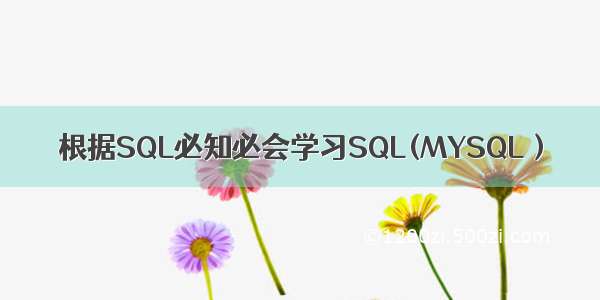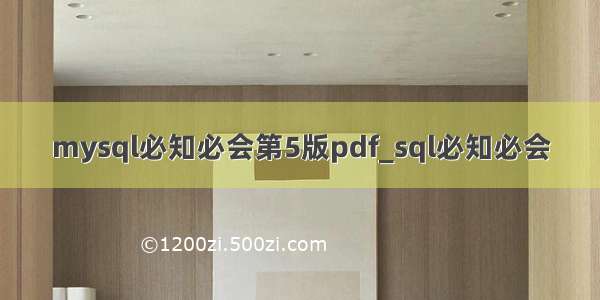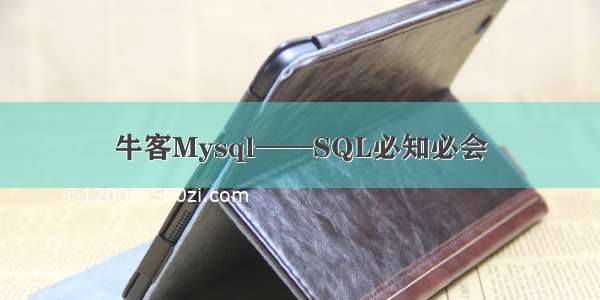
很久都没有整理SQL语句了,遇到让写SQL语句的题也很迷茫,所以就重拾一下知识,本文章根据SQL必知必会进行梳理
文章目录
一、检索所有列1.select1.1检索单个列1.2 检索多个列1.3 检索所有列1.4 检索不同值1.5 限制结果1.6 使用注释 二、排序检索数据2.1 按照多个列排序2.2 按照列位置排序2.3 指定排序方向 三,过滤数据3.1 使用where子句4.2检查单个值4.3不匹配查询4.4范围值查询4.5空值查询 五,高级数据过滤5.1使用and5.2使用or5.3使用in 六,用通配符进行过滤6.1 %通配符6.2 _通配符 七,使用函数7.1 upper函数7.2 日期处理函数 八,聚集函数8.1avg()函数求平均值8.2count()函数求总数8.3max()函数求最大值8.4sum()函数求和 九,分组数据9.1创建分组9.2 过滤分组9.3分组和排序9.4select子句顺序 十,使用子查询十一 联结表11.1创建连接11.2创建外连接 十二 数据插入十三 数据更新和删除十四 创建和操纵表十五 游标一、检索所有列
1.select
1.1检索单个列
查找所有的产品名称select prod_namefrom products;
注意:sql语句不区分大小写
返回结果:
1.2 检索多个列
查询商品id,查询商品名称,查询商品价格select prod_id,prod_name,prod_pricefrom products;
返回结果:
1.3 检索所有列
查询products表中的所有信息select*from products;
1.4 检索不同值
查询产品供货商select vend_idfrom products;
展示结果:
这里我们发现,展示了所有的供货商,但是有重复,实际只有三个供应商,此时如果只是想展示3个供应商,那么就需要使用distinct关键字
查询产品供应商select distinct vend_idfrom products;
注意:distinct关键字作用域后面的所有列
1.5 限制结果
mysql中取出前两行的数据select prod_idfrom productslimit 2;
如果是从第二行开始,后面的两行select prod_idfrom productslimit 2 offset 2;
这里单纯的限制多少行,使用limit就足够了,限制从第几行开始之后的几行,就需要使用limit和offset
1.6 使用注释
在sql语句中,注释使用的是: --/* */
二、排序检索数据
2.1 按照多个列排序
使用关键字 order by,想对哪一列进行排序,就把他放在order by后面
查询商品号,商品价格,商品名称,首先按照价格排序,然后按照名称排序select prod_id,prod_price,prod_pricefrom productsorder by prod_price,prod_name;
我们发现商品的价格进行了从小到大的排序
2.2 按照列位置排序
查询商品号,商品价格,商品名称,首先按照价格排序,然后按照名称排序select prod_id,prod_price,prod_pricefrom productsorder by 2,3;
可以看到和上一个列明列出来的效果是相同的
2.3 指定排序方向
查询商品号,商品价格,商品名称,首先按照价格排序,然后按照名称排序select prod_id,prod_price,prod_pricefrom productsorder by 2,3 desc;
==默认的都是升序asc,如果我们想要按照降序排列就需要关键字desc ==
desc只应用在他之前的那一列中,如果想对每一列都进行降序,那么只能在每一列中都增加desc
三,过滤数据
3.1 使用where子句
查找产品价格等于32.4的产品名称select prod_name,prod_pricefrom productswhere prod_price = 32.4;
这里有一个疑问,假如没有我们想要查询的信息,数据库将会给我们返回什么?
答案是:返回空
4.2检查单个值
输出价格低于30的所有产品名select prod_name,prod_pricefrom productswhere prod_price < 30;
4.3不匹配查询
查询制造商不是DLL001的商品名select prod_name,vend_idfrom productswhere vend_id != 'DLL001';
在这里本作者出了一个错误,就是’DLL001’没有带单引号,希望读者可以注意这个问题,共勉
4.4范围值查询
查询产品价格在10元到20元之间的产品select prod_name,prod_pricefrom productswhere prod_price between 10 and 20;
4.5空值查询
查询价格为空的商品select prod_name,prod_pricefrom productswhere prod_price is null;
五,高级数据过滤
5.1使用and
找出商品价格大于20并且制造商为DLL001的所有商品select prod_name,prod_price,vend_idfrom productswhere prod_price > 20 and vend_id = 'DLL001';
5.2使用or
找出制造商为DLL001或BRS01的商品select prod_name,vend_idfrom productswhere vend_id='DLL001' or vend_id = 'BRS01';
5.3使用in
查找制造商在DLL001和BRS01里的商品select prod_name,vend_idfrom productswhere vend_id in('DLL001','BRS01');
六,用通配符进行过滤
6.1 %通配符
找商品名称为pro起头的商品名称select prod_namefrom productswhere prod_name like 'pro%';
他不仅可以匹配以什么开头,还可以匹配中间有什么字符的
找到以roducts为中间的商品名select prod_namefrom productswhere prod_name like '%roducts%';
6.2 _通配符
找商品名称为pro起头的商品名称select prod_namefrom productswhere prod_name like 'pro_';
可以看出区别了吗?%通配符适用于匹配多个字符,而_只能匹配单个字符
七,使用函数
7.1 upper函数
将商品名称全部转换为大写select prod_name,upper(prod_name) as prod_name2from productsorder by prod_name;
7.2 日期处理函数
省略
八,聚集函数
8.1avg()函数求平均值
算出所有商品的价格平均值select avg(prod_price) as avg_pricefrom products;
获得厂商为DLL001的商品价格平均值select vend_id,avg(prod_price) as avg_pricefrom productswhere vend_id = 'DLL001';
8.2count()函数求总数
求所有商品的总数select count(prod_id) as count_prodfrom products;或者select count(*) as count_prodfrom products;
8.3max()函数求最大值
求商品价格的最大值select max(prod_price) as max_pricefrom products;
8.4sum()函数求和
求所有商品的价值总和select sum(prod_price) as sum_pricefrom products;
九,分组数据
9.1创建分组
创建分组我们使用的是group by
查询不同的制造商制造几种商品select vend_id,count(*) as varible_vend_sumfrom productsgroup by vend_id;
需要注意的一点是:group by 子句必须出现在where之后,order by之前
9.2 过滤分组
错误示范
查询制造商制造种类大于2的制造商
select vend_id,count() as varible_vend_sum
from products
where count() >= 2
group by vend_id;
他会报错,为什么呢?因为where语句后面应该跟的是原本就存在的列,而不是基于过滤分组后的列,这时候我们就应该使用having关键字了
查询制造商制造种类大于2的制造商select vend_id,count(*) as varible_vend_sumfrom productsgroup by vend_idhaving count(*) >= 2;
但是有没有既拥有where的sql语句又拥有having的sql语句的查询呢?有,下面就是个例子
查询开发商制造大于两个种类的产品,并且产品价格高于18.3的开发商select vend_id,count(*) as varible_vend_sumfrom productswhere prod_price > 18.3group by vend_idhaving count(*) >= 2;
9.3分组和排序
我们前面讨论过,order by,那order by 和group by有什么区别呢?
order by对产生的输出结果进行排序,通常有两种排序方式,一种是升序asc,一种是降序desc,任意列都能使用。group by对行进行分组,但是输出的不一定是分组的顺序,只可能使用选择列或表达式列,如果与聚集函数一起使用,那么就必须使用group by
我们延续上面的例子
查询制造商制造种类大于1的制造商select vend_id,count(*) as varible_vend_sumfrom productsgroup by vend_idhaving count(*) >= 1;
如果我们还要求输出的数目应该按照升序排列,那么
查询制造商制造种类大于1的制造商,并且按照数量升序排列select vend_id,count(*) as varible_vend_sumfrom productsgroup by vend_idhaving count(*) >= 1order by varible_vend_sum,vend_id;
9.4select子句顺序
十,使用子查询
检索包含物品RGAN01的所有订单的编号select oder_numfrom oderitemswhere prod_id = 'RGAN01';检索具有RGAN01订单编号的所有顾客的IDselect cust_idfrom orderswhere order_num in(select order_numfrom oderitemswhere prod_id = 'RGAN01');显示customers表中每个顾客的订单总数select cust_name,(select count(*) from orderswhere orders.cust_id = customers.cust_id) as ordersfrom customersorder by cust_name;
十一 联结表
11.1创建连接
求开放商名称,商品名称,商品价格select vend_name,prod_name,prod_pricefrom vendors,productswhere vendors.vend_id = products.vend_id;
其实上述的联结是等值连接,也称为内连接
换一种写法select vend_name,prod_name,prod_pricefrom vendors inner join products on venders.vend_id = products.vend_id;查询商品名称,查询开发商名称,商品价格,物品数量,并且订单号为20007select prod_name,vend_name,prod_price,quantityfrom oderitems,vendors,productorswhere odertimes.prod_id = products.idand vendors.vend_id = vendors.vend_id
11.2创建外连接
外连接包括左外连接和右外连接,两个在本质上是没有区别的,左连接关键字是left outer join... on...,右连接的关键字是right outer join...on。外连接主要就是为了显示没有的东西,比如我想要查询没有订单的用户,我需要分析他们为什么么有买东西,这时候就需要进行外连接。查询包括没有订单顾客在内的所有顾客select customers.cust_id,order.order_numfrom customers left outer join oderson customers.cust_id = orders.cust_id;
十二 数据插入
使用关键字insert
插入完整的行insert into customersvalues('xx','dsj',...);插入部分行insert into customers(插入的行)values(值);
十三 数据更新和删除
更新使用update关键字,删除使用delete关键字
更新用户193690的电子邮箱地址update customersset cust_email ='shakhdn@'where cust_id = '193690';
delete有两种用法,删除特定的行,从表中删除所有的行
删除customers中的一行,顾客id为23728979detete from customerswhere cust_id = '23728979';
十四 创建和操纵表
创建表create table 表名(列名字 类型 是否为null,列名字2 ... );
默认值设置为default
更新表alter table ...add ...;
十五 游标
创建表declare 游标名cursorforselect ...;使用游标open cursor ...关闭游标close 游标名














